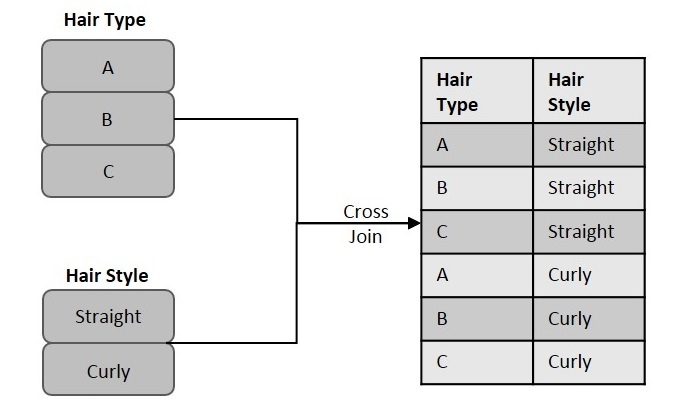sql
Khóa học miễn phí SQL – Cross Join nhận dự án làm có lương
SQL – Cross Join
The SQL Cross Join
An SQL Cross Join is a basic type of inner join that is used to retrieve the Cartesian product (or cross product) of two individual tables. That means, this join will combine each row of the first table with each row of second table (i.e. permutations).
A Cartesian product, or a cross product, is the result achieved from multiplication of two sets. This is done by multiplying all the possible pairs from both the sets.
The sample figure below illustrates the cross join in a simple manner.

As you can see, we considered two table columns: Hair Style and Hair Type. Each of these columns contain some records that need to be matched. Hence, using cross join, we combine each record in the “Hair Style” column with all records in the “Hair Type” column. The resultant table obtained is considered as the Cartesian product or Joined table.
Syntax
Following is the basic syntax of the Cross Join query in SQL −
SELECT column_name(s) FROM table1 CROSS JOIN table2;
Example
Assume we have created a table named CUSTOMERS, which contains the personal details of customers including their name, age, address and salary etc., using the following query −
CREATE TABLE CUSTOMERS ( ID INT NOT NULL, NAME VARCHAR (20) NOT NULL, AGE INT NOT NULL, ADDRESS CHAR (25), SALARY DECIMAL (18, 2), PRIMARY KEY (ID) );
Now, insert values into this table using the INSERT statement as follows −
INSERT INTO CUSTOMERS VALUES (1, ''Ramesh'', 32, ''Ahmedabad'', 2000.00 ), (2, ''Khilan'', 25, ''Delhi'', 1500.00 );
The table will be created as −
| ID | NAME | AGE | ADDRESS | SALARY |
|---|---|---|---|---|
| 1 | Ramesh | 32 | Ahmedabad | 2000.00 |
| 2 | Khilan | 25 | Delhi | 1500.00 |
Let us create another table ORDERS, containing the details of orders made and the date they are made on.
CREATE TABLE ORDERS ( OID INT NOT NULL, DATE VARCHAR (20) NOT NULL, CUSTOMER_ID INT NOT NULL, AMOUNT DECIMAL (18, 2) );
Using the INSERT statement, insert values into this table as follows −
INSERT INTO ORDERS VALUES (100, ''2009-10-08 00:00:00'', 3, 1500.00), (101, ''2009-11-20 00:00:00'', 2, 1560.00);
The table is displayed as follows −
| OID | DATE | CUSTOMER_ID | AMOUNT |
|---|---|---|---|
| 100 | 2009-10-08 00:00:00 | 3 | 1500.00 |
| 101 | 2009-11-20 00:00:00 | 2 | 1560.00 |
Now, if we execute the following Cross Join query on these two tables given above, the cross join combines each row in CUSTOMERS table with each row in ORDERS table.
SELECT ID, NAME, AMOUNT, DATE FROM CUSTOMERS CROSS JOIN ORDERS;
Output
The resultant table is as follows −
| ID | NAME | AMOUNT | DATE |
|---|---|---|---|
| 2 | Khilan | 1500.00 | 2009-10-08 00:00:00 |
| 1 | Ramesh | 1560 | 2009-11-20 00:00:00 |
| 2 | Khilan | 1560 | 2009-11-20 00:00:00 |
| 1 | Ramesh | 1500.00 | 2009-10-08 00:00:00 |
Joining Multiple Tables with Cross Join
We can also join more than two tables using cross join. In this case, multiple-way permutations are displayed and the resultant table is expected to contain way more records than the individual tables.
Syntax
Following is the syntax to join multiple tables using cross join in SQL −
SELECT column_name(s) FROM table1 CROSS JOIN table2 CROSS JOIN table3 CROSS JOIN table4 .... .... .... CROSS JOIN tableN;
Example
Assume we have created another table named ORDER_RANGE using the following query −
CREATE TABLE ORDER_RANGE ( SNO INT NOT NULL, ORDER_RANGE VARCHAR (20) NOT NULL );
Now, we can insert values into this empty tables using the INSERT statement as follows −
INSERT INTO ORDER_RANGE VALUES (1, ''1-100''), (2, ''100-200''), (3, ''200-300'');
The ORDER_RANGE table is created as follows −
| SNO | ORDER_RANGE |
|---|---|
| 1 | 1-100 |
| 2 | 100-200 |
| 3 | 200-300 |
Following query combines the three tables CUSTOMERS, ORDERS and ORDER_RANGE, using cross join −
SELECT ID, NAME, AMOUNT, DATE, ORDER_RANGE FROM CUSTOMERS CROSS JOIN ORDERS CROSS JOIN ORDER_RANGE;
Output
The resultant table is given below −
| ID | NAME | AMOUNT | DATE | ORDER_RANGE |
|---|---|---|---|---|
| 2 | Khilan | 1560 | 2009-11-20 00:00:00 | 1-100 |
| 1 | Ramesh | 1560 | 2009-11-20 00:00:00 | 1-100 |
| 2 | Khilan | 1500.00 | 2009-10-08 00:00:00 | 1-100 |
| 1 | Ramesh | 1500.00 | 2009-10-08 00:00:00 | 1-100 |
| 2 | Khilan | 1560 | 2009-11-20 00:00:00 | 100-200 |
| 1 | Ramesh | 1560 | 2009-11-20 00:00:00 | 100-200 |
| 2 | Khilan | 1500.00 | 2009-10-08 00:00:00 | 100-200 |
| 1 | Ramesh | 1500.00 | 2009-10-08 00:00:00 | 100-200 |
| 2 | Khilan | 1560 | 2009-11-20 00:00:00 | 200-300 |
| 1 | Ramesh | 1560 | 2009-11-20 00:00:00 | 200-300 |
| 2 | Khilan | 1500.00 | 2009-10-08 00:00:00 | 200-300 |
| 1 | Ramesh | 1500.00 | 2009-10-08 00:00:00 | 200-300 |
Khóa học lập trình tại Toidayhoc vừa học vừa làm dự án vừa nhận lương: Khóa học lập trình nhận lương tại trung tâm Toidayhoc
Notice: Trying to access array offset on value of type bool in /home/edua/htdocs/edu.toidayhoc.com/wp-content/themes/flatsome/flatsome/inc/shortcodes/share_follow.php on line 41

